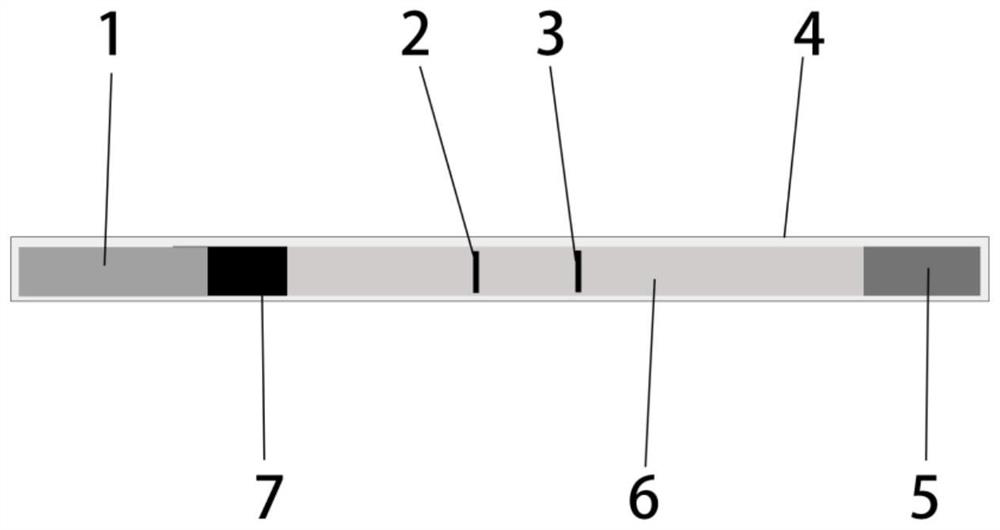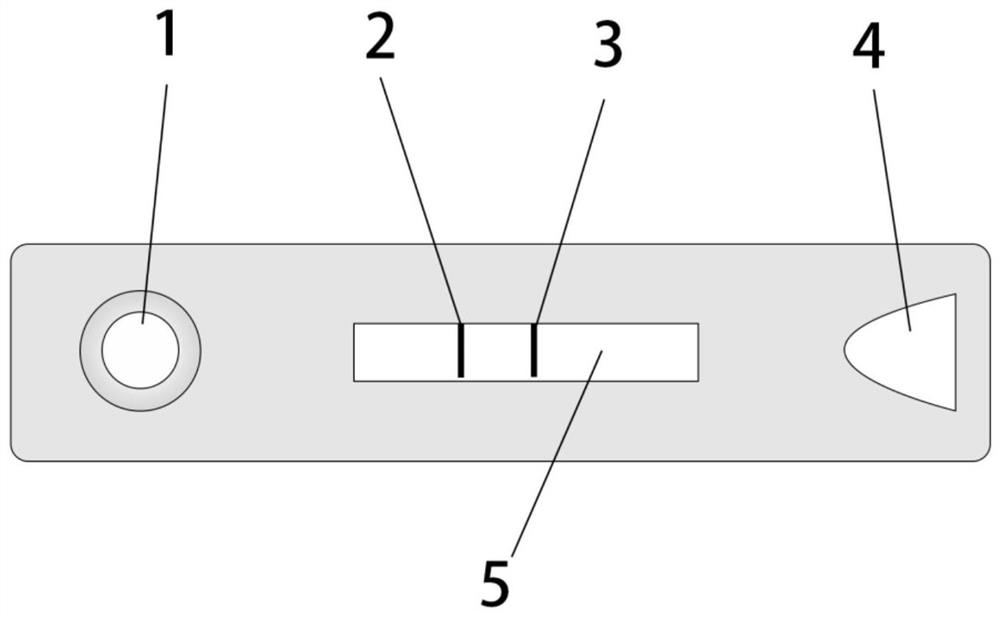Preparation and application of fluorescence immunochromatography test strip for exosome quantification
A technology of fluorescent immunochromatography and test strips, which is applied in the direction of measuring devices, analytical materials, instruments, etc., can solve the problems of inconvenient downstream experiments, inability to remove pollution, expensive instruments, etc., and achieve simple, convenient and accurate exosomes in the experimental process Concentration, simple effect of equipment
- Summary
- Abstract
- Description
- Claims
- Application Information
AI Technical Summary
Problems solved by technology
Method used
Image
Examples
Embodiment 1
[0047] Example 1 A fluorescent immunochromatographic test strip for detecting exosomes provided by the present invention
[0048] Such as figure 1 As shown, the fluorescent immunochromatographic test strip test for detecting exosomes includes a back plate and a sample pad pasted on the back plate, a binding pad, an NC film, and a water-absorbing pad, wherein the binding pad is connected to the sample pad and the NC film respectively. One end of the membrane is overlapped, and the other end of the NC membrane is overlapped with the absorbent pad. The NC membrane is a nitrocellulose membrane with a pore size of 450-700nm, and the sample pad and binding pad are polyester membranes.
[0049] Such as figure 2As shown, the NC membrane is sprayed with detection lines and quality control lines, and the binding pad is attached with fluorescent microsphere-labeled mouse anti-human CD9 antibody and fluorescent microsphere-labeled rabbit IgG. The fluorescent microspheres have a particl...
Embodiment 2
[0050] Example 2 The method of the fluorescent immunochromatographic test strip for detecting exosomes provided by the present invention
[0051] 1. CD9 Antibody and Rabbit IgG Fluorescent Microsphere Labeling
[0052] (1) Fluorescent microspheres are activated
[0053] Take 200ul of fluorescent microspheres with a solid content of 1% and add them to a centrifuge tube, and add 1ml of MES buffer solution (MES200mg / ml), mix well, put into a centrifuge, centrifuge at 6000g for 5min, and remove the supernatant. Then add 1ml of MES buffer (MES 200mg / ml) to the centrifuge tube to resuspend the fluorescent microspheres, then add 100ul (20mg / ml) EDC and 100ul (20mg / ml) NHS to the solution, shake and mix After 40 minutes, place the centrifuge tube in a centrifuge, centrifuge at 6000 g for 5 minutes, and suck off the supernatant.
[0054] (2) Fluorescent microsphere labeling of CD9 monoclonal antibody
[0055] Add 1ml of MES buffer (MES 200mg / ml) to the activated microspheres, mix by...
Embodiment 3
[0074] Example 3 The method provided by the present invention for detecting the concentration of exosomes using the fluorescent immunochromatographic test strip
[0075] Concentration detection of exosome samples
[0076] Step 1: Sample Preparation
[0077] Take an appropriate amount of exosome sample, add sample diluent to the exosome sample, and mix well to form an exosome sample mixture.
[0078] Step 2: Prepare test strips
[0079] Remove the outer packaging of the test paper card sample, place the test paper card on a horizontal plane, and set it aside.
[0080] Step 3: Adding samples
[0081] Aspirate 80-100ul exosome sample mixture, add it to the sample slot of the test paper card, and time it.
[0082] Step 4: Data Detection
[0083] After 15 minutes, the test paper card was placed in a fluorescent immunoassay analyzer (purchased from Guangzhou Lanbo Biotechnology Co., Ltd.) to detect the concentration of exosomes.
[0084] Quantification of Exosome Concentration...
PUM
| Property | Measurement | Unit |
|---|---|---|
| pore size | aaaaa | aaaaa |
| particle size | aaaaa | aaaaa |
| diameter | aaaaa | aaaaa |
Abstract
Description
Claims
Application Information
 Login to View More
Login to View More - R&D
- Intellectual Property
- Life Sciences
- Materials
- Tech Scout
- Unparalleled Data Quality
- Higher Quality Content
- 60% Fewer Hallucinations
Browse by: Latest US Patents, China's latest patents, Technical Efficacy Thesaurus, Application Domain, Technology Topic, Popular Technical Reports.
© 2025 PatSnap. All rights reserved.Legal|Privacy policy|Modern Slavery Act Transparency Statement|Sitemap|About US| Contact US: help@patsnap.com



